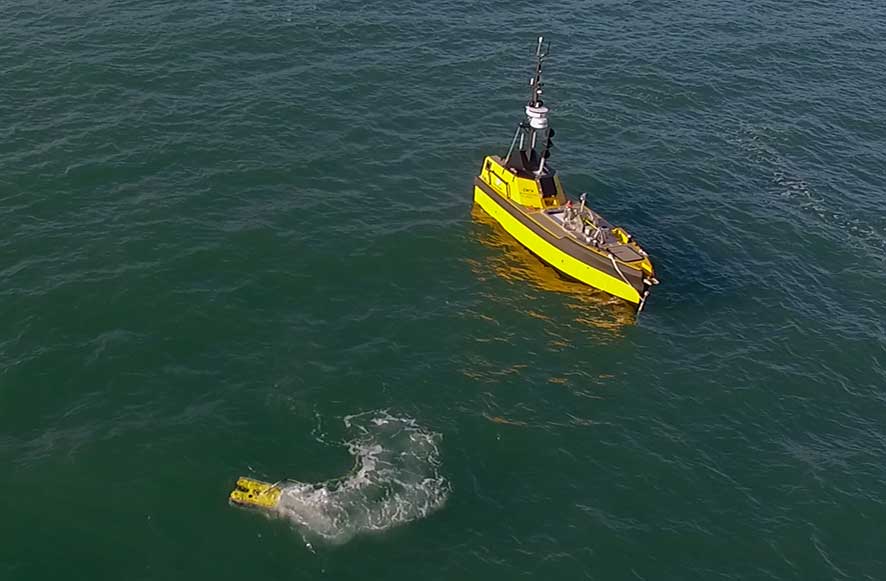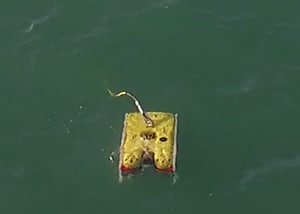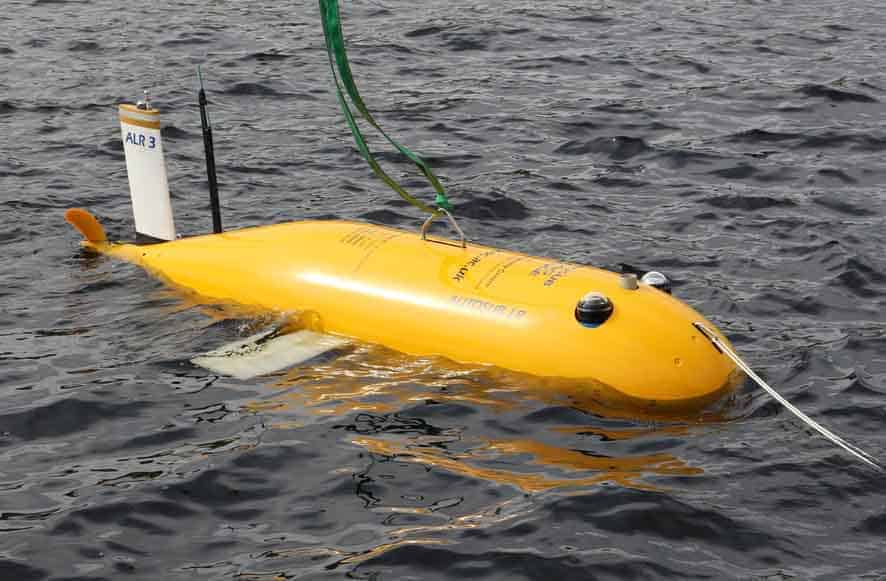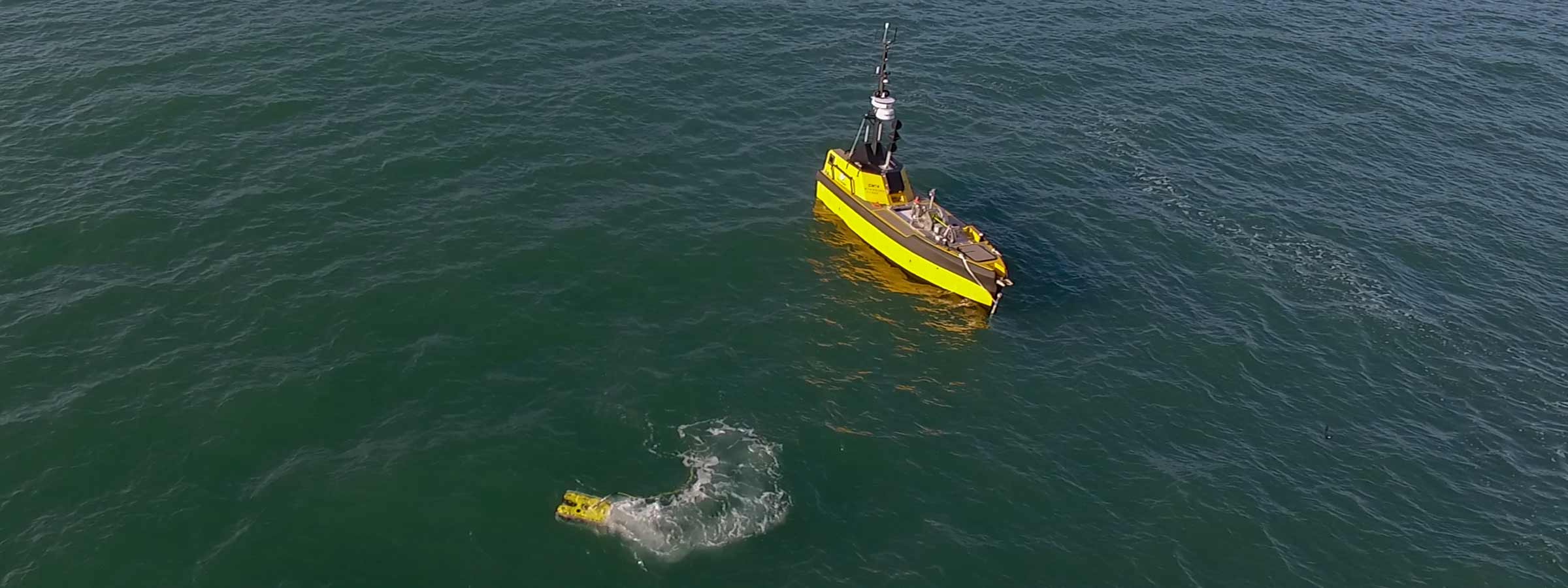One of the early promises made by the advent of unmanned or autonomous underwater vehicle (UUV/AUV) systems was a world free of the need for costly surface support vessels. It’s a promise these vehicles have struggled to meet.
They have delivered value – in other ways. They offer a stable platform close to the seabed where they’re able to acquire high-resolution actionable data. But if you want to know very accurately where in the world that data is, a surface ship providing acoustic position updates is still part and parcel of the mission. These can be ships that are smaller and less costly than those required for conventional operations, but they are necessary.
In addition, if you want to use manipulators, like those used by remotely operated vehicle (ROV), there isn’t the bandwidth to provide the video feed that would enable the level of human-in-the-loop control needed to support complex operations.
So what are the options? How about replacing the support vessel and doing your over-the-horizon ROV or unmanned underwater vehicle (UUV) operations with an unmanned surface vehicle (USV)?
Over-the-horizon USV operations; what are the challenges?
 In the ocean science community and the oil and gas industry alike, many missions require an ROV to dive, inspect and interact with its environment. How can we support these types of operations if we don’t want to use a ship?
In the ocean science community and the oil and gas industry alike, many missions require an ROV to dive, inspect and interact with its environment. How can we support these types of operations if we don’t want to use a ship?
Navies want to keep mine countermeasure (MCM) vessels away from the minefield. It makes their manufacture less costly. To make that concept of operation viable, UUVs and other so-called offboard assets will need to be managed from those MCM ships, which stay outside the field of operations. The challenge then becomes how to enable those MCM vessels to track and communicate with the offboard underwater assets over significant horizontal distances?
We’ve been scratching our heads trying to solve those challenges for our customers. Fortunately, we have come up with some neat solutions, which we think will add a lot of value to USV manufacturers. They will also help make the transition to truly unmanned ROV and UUV operations.
Unmanned, on-demand, remote ROV operations
 This is not simple. USV designs capable of supporting ROV operations are a key consideration. However, we also need to make the ROV and USV combination an unmanned maritime system (UMS) capable of autonomous operation. How? They need to do what a UUV does: find their position in real-world coordinates and continually manage their actuators and thrusters to get to where they want to be. But they have to do this in partnership with a USV. How do we help? We provide hybrid navigators, like our popular SPRINT-Nav, and we can tie the relative position of the ROV to the surface vessel using our 6G Ultra-Short BaseLine (USBL) acoustic positioning systems.
This is not simple. USV designs capable of supporting ROV operations are a key consideration. However, we also need to make the ROV and USV combination an unmanned maritime system (UMS) capable of autonomous operation. How? They need to do what a UUV does: find their position in real-world coordinates and continually manage their actuators and thrusters to get to where they want to be. But they have to do this in partnership with a USV. How do we help? We provide hybrid navigators, like our popular SPRINT-Nav, and we can tie the relative position of the ROV to the surface vessel using our 6G Ultra-Short BaseLine (USBL) acoustic positioning systems.
L3Harris, who manufacture the C-Worker family of USVs, have worked with us on this. In the ARISE* project, they used our Ranger 2 USBL system and our Wideband Sub-Mini 6 Plus (WSM 6+) positioning beacons to acoustically track a Saab Seaeye Falcon ROV from one of their C-Worker 7 USVs. James Cowles, Business Development Manager at L3Harris, pointed out to me recently, “Autonomy will bring a range benefits to industry including reduced operational costs and fewer people working at sea. A key enabler for the interoperation of surface and subsurface autonomous systems is subsea positioning. The full benefits of collaborative autonomy will be realised through enabling the systems to understand each other’s relative position in complex environments of operation.”
Over-the-horizon control for UUV operations
 As we’ve just seen, ROV systems working in tandem with USV systems are on their way to an autonomous future. To a degree, they have it easy – there is an actual cable physically connecting the ROV to the USV. This tether provides all the vital information required so that the autonomy engine can make the right decisions at the right time. With fibre optic cables you can share a lot of information. UUVs, on the other hand, don’t have a tether to connect them to the surface.
As we’ve just seen, ROV systems working in tandem with USV systems are on their way to an autonomous future. To a degree, they have it easy – there is an actual cable physically connecting the ROV to the USV. This tether provides all the vital information required so that the autonomy engine can make the right decisions at the right time. With fibre optic cables you can share a lot of information. UUVs, on the other hand, don’t have a tether to connect them to the surface.
Acoustics come to the rescue here. We already use acoustics to track and communicate with UUVs from vessels of opportunity. Simply equip your UUV with an AvTrak 6 (our 3-in-1 USBL transponder, transceiver and modem, for acoustic navigation and communications) and deploy one of our USBL systems on the surface. You are set. Because both are based on our 6G hardware and use our Wideband 2 advanced digital signal protocols, you’ll be able to send your UUV reliable USBL position updates while simultaneously getting status updates from the UUV.
The next trick we need to perform to make this work on a USV is to make the human disappear, in other words take the human out of the loop.
How do we do this? We developed a remote control input, which we imaginatively coined Remote Control. Tom Bennetts, Applications Group Manager, explains it best: “Remote Control interfaces to the USBL systems via the serial or UDP COM port. The remote interface accepts input commands to the USBL and outputs UUV positions and SMS messages (Sonardyne speak for ASCII-Hex messages). A USV can use it to take control of the USBL and the UUV. Now you can talk to one UUV (read more here) or a swarm.”
The technology has been put the test. Again, it was L3Harris who we worked with early on. Their USV, this time a C-Worker 5, was used to track and communicate with an Autosub Long Range (ALR), a UUV manufactured by the UK’s National Oceanography Centre. The project was called Autonomous Surface/Subsurface Survey System or ASSSS. James Cowles points out, “ASSSS demonstrated that USV systems can increase the effectiveness and efficiency of UUV systems by providing up to date position information. This enables operations without a mothership even during over the horizon operations. We are already working towards making this technology much more widely available.”
What does it all mean?
Whether you are looking to track an ROV or a UUV from a USV, we’ve got you covered. Our systems can be upgraded with a Robotics Pack that unlocks the Remote Control feature. Talk to us if you would like to find out more.
*Autonomous Robotic Intervention System for Extreme Maritime Environments (ARISE). Read more here: https://www.asvglobal.com/arise/
